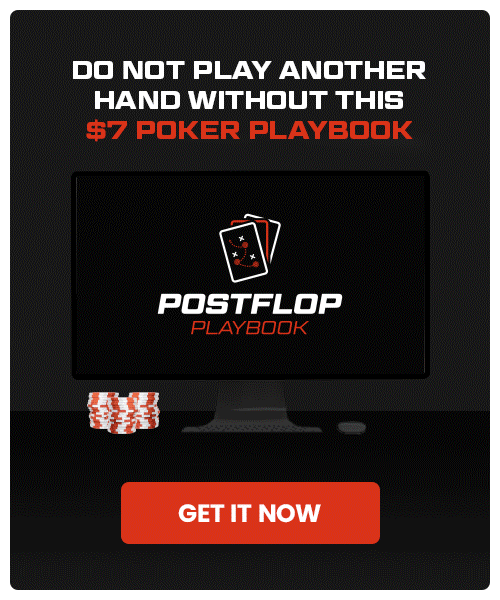How to Play Low Suited Jacks in Cash Games (J8s–J2s)
If you are looking to extract every ounce of money that you can from your opponents, learning how to play the low suited Jacks will help.
You might be thinking “low suited Jacks? Why would I ever play those?!”
I won’t bury the lead here: these aren’t great starting hands and the best strategy is usually to fold when you have them.
But there are some situations in which playing a hand like or can win you money.
This article will help you identify those situations so you’ll be ready to scoop up some extra pots.
Here’s what I’ll cover:
- How to Play Low Suited Jacks Preflop
- 3 Tips for When You Miss the Flop
- 3 Tips for When You Hit the Flop
Let’s dive in!
I’ll be using shorthand to refer to different starting hands in this article. For example:
J8s = Jack-Eight suited
J6s = Jack-Six suited
J2s = Jack-Two suited
How to Play J8s–J2s Suited Preflop
Put simply, there aren’t that many situations in which you should play these hands before the flop.
I’ll go over the spots in which these hands profit in this section. But first, here are the positions that will be referenced in this section:
Unopened Pots
When the action folds to you, you should only raise with low suited Jacks from the Button and the Small Blind. From all other positions, these hands are simply too weak to raise with.
There is an exception here: you can profitably open-raise with Jack-Eight suited and Jack-Seven suited from the Cutoff, specifically. But from that same position, you should let Jack-Six suited go.
Against a Raise
You should usually fold low suited Jacks when you’re facing a raise, but there is an exception.
When you’re in the Big Blind, you can sometimes call with low suited Jacks. But it depends on the position of the player who raised and the size of the raise.
If a player from UTG through Hijack raises to 2.5bb, then only J8s is a profitable call. J7s becomes a marginal call against the Hijack. Against raise of 3bb or bigger, folding all low suited Jacks is best.
If the Cutoff raises to 2.5bb, then you should always call with J8s and J7s. But if he raises to 3bb, then you should only call with J8s. That extra half of a big blind actually makes J7s become a losing call (on average).
Against a Button raise of 2.5bb, you should call with J8s through J5s. You can sometimes call with the lower ones. Against a 3bb raise, you should only call with J7s or better.
Against a 3-Bet
You should basically always fold when you are holding a low suited Jack against a 3-bet. The only exception is if you raise and your opponent 3-bets to a comically small size.
Note: Do not play another hand without this $7 Postflop Playbook! With such a low price tag, Doug Polk’s Postflop Playbook is a no-brainer buy if you want to nail down your fundamentals and build a bigger bankroll. Level-up your poker skills now!
3 Tips for Playing When You Miss the Flop (As the Preflop Raiser)
Most of the time, you won’t flop a pair or better with your low suited Jack (or any non-paired hand for that matter).
These tips will help you navigate those situations.
Tip #1 – With a backdoor flush or straight draw, you should fire a bet very often
Backdoor draws can be very useful!
These runner-runner draws are great bluffing candidates. Not only do they hit disguised monsters every once in a while, but they also diversify your range of hands, making your less predictable.
For example: suppose you raise from the Button with and the Big Blind called.
The flop comes and your opponent checks. You should c-bet every single time with this hand. You have a backdoor flush draw (running diamonds will give you a flush) and many backdoor straight opportunities (any , , , or turn will give you a straight draw).
If you bet on the flop and get called, you can continue betting on any turn that gives you one of those draws. Facing that kind of aggression will not be easy for your opponent!
You should pull the trigger with these types of bluffs if you are serious about playing at a high level.
Tip #2 – When you flop a flush draw, always bet
The Jack-high flush draws are great semi-bluffing hands because they have no showdown value and 9 outs to hit a flush. By betting on the flop, you will force folds from a lot of stronger hands right away. And if that doesn’t work and you miss your flush on the turn, you can still hit the flush on the river.
For example: suppose you raise from the Cutoff with and the Big Blind calls. The flop comes and your opponent checks. Always bet with a hand like this!
Tip #3 – When you flop a straight draw, always bet
This is basically the same idea as tip #2.
Straight draws might not hit as often as flush draws, but they are still good enough to bet!
If you hit the straight, you can start trying to extract value from your opponent. Furthermore, playing bluffs aggressively like this helps disguise your value hands. Your opponent won’t know if you actually hit the flop or if you’re just bluffing with a draw.
Quick note about draws:
- When you have a flush draw, you have 9 outs to improve to a flush (36% chance of hitting a flush by the river).
- When you have an open-ended straight draw, you have 8 outs to improve to a straight (32% chance of hitting).
- And when you have a gutshot straight draw, you have 4 outs to improve (16% chance).
3 Tips for Playing When You Hit the Flop
Sometimes you’ll hit a pair or better on the flop. These tips will help you play better in those situations.
Tip #1 – C-bet when you hit top pair on a low flop
When you have the top pair in poker, it’s crucial to consider its vulnerability.
On one hand, top pair on an Ace-high flop (e.g. on ) is not vulnerable at all. There are no overcards that can come, so your top pair of Aces doesn’t have too much to worry about.
On the other hand, top pair on a Seven-high flop (e.g. on ) is very vulnerable. Over half the deck is an overcard, so your top pair really benefits from denying equity.
Denying equity is when you force your opponent to fold a hand that had outs to beat you.
When you have a low top pair, betting is usually the best option because it protects your strong-but-vulnerable hand.
For example, checking with a hand like J8s on a board like isn’t ideal. The turn can diminish your hand’s value when any overcards appear. So, lean towards betting with these types of hands.
Tip #2 – Check more often when you flop top pair with the Jack
Compared to lower top pairs, the Jack-high top pair is less vulnerable. Only three overcards can diminish its value on the turn.
Additionally, you will have kicker problems on these Jack-high boards, which makes it less appealing to aggressively build the pot with a bet.
Therefore, waiting until the turn to bet for value with your top pair of Jacks, and then playing aggressively on most rivers, is usually the best option strategy.
For example, say you have J5s on a flop. In this spot, checking is a great play. You will have an easy call on the turn if your opponent bets. Or, in case your opponent checks on the turn, you have an easy bet and barrel for value.
Tip #3 – When you have a flush draw to go with your top pair, play aggressively
This is an exception to tip #2.
When you have a flush draw to go with your top pair, this greatly increases the value of your hand and should make you more willing to build the pot. This makes a hand like on a worth betting for value.
Even if you do happen to be outkicked, you have a ton of backup equity in the form of your flush draw.
Final Thoughts
The medium and low suited hands are a small piece of the poker puzzle. But your win-rate will tick upward if you follow the ideas I presented in this article.
That’s all for this article! I hope you had fun reading it!
If you want to learn how to play more starting hands, scroll down to Related Posts below and pick the guide that interests you. I’ve written dozens of these to help players like you improve their skills.
Till’ next time, good luck, grinders!
When you get The Postflop Playbook, you will learn how to make quick and profitable decisions that translate to more (and bigger) winning poker sessions. Learn more now!

